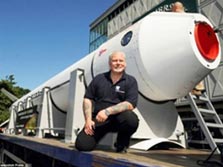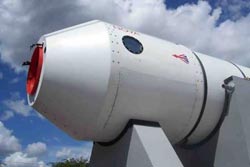Homemade rockets to fly into space
The missile in the attached photo may not be consistent with the strict specifications of the US Aerospace Agency (NASA), but it will most likely help the British to overcome the limits of the atmosphere to enter the Universe. cylinder.
"The creator of this 'Nova-2' rocket, Steve Bennett, a rocket scientist who is a chemical engineer specializing in toothpaste, said:"
'In the next 2 years, this kind of missile will take visitors to the space'.
Not only that, this dynamic scientist also believes that he will win awards in the space travel competition and defeat the powerful competitor group with multi-billion dollar capital including horn scientists. So, including Dr. Browson, President of British Viking Group.
Steve Bennett said: 'They have more money, but we have more missile experience. We almost certainly won. The problem is not how much he spent or how much he spent it. '
Currently Steve Bennett is a lecturer in space and physics. Before he could fly into space, an unknown world, he had to overcome many obstacles. First of all is the issue of capital. His program needs 11 million pounds, but he currently lacks 7 million.


Steve Bennett and his rocket.(Photo: Starchaser.co.uk)
Another issue that needs to be addressed is the launch pad. He plans to build a 'Space Center', but progress is delayed so far the launch pad is still a construction site.
Not only that, the 43-year-old scientist also has to deal with critical opinions of outsiders.
In 1998, his design missile was dropped only seconds after leaving the launch pad and causing a fire. At that time, everyone criticized him for being unrealistic, unrealistic.
Currently, Steve Bennett focuses all efforts on the 'Nova-2' rocket, the largest type of British rocket. By design, this missile can fly to a height of 36 km after 3 minutes leaving the launch pad.
The 22 meter long missile, which weighs about a ton, is expected to be launched in September 2009. The flight does not bring this person to focus on safety. The launch pad is expected to be built in Morkan Bay in northwestern England.
If successful, then in 2013, a rocket carrying the first visitors will be launched into space. The missile weighs 17 tons, at a speed of 5000 km / hour, after 23 minutes it has reached a height of 100 km, which is considered the beginning of the universe, then will return to Earth.
The passenger compartment carrying 3 people will descend to the ground with an umbrella. Two Britons spent 25,000 pounds each to be the first space traveler.
Before flying, they will have to undergo training for the body to withstand the weightless state. Steve Bennett will accompany them throughout the flight. He said: 'Those years have been a dream, but now I find myself getting closer to reality'.
- How does rocket work in space?
- Iran is preparing to launch 2 homemade satellites into orbit
- The first homemade rocket is about to be launched into space
- The boy survived thanks to a homemade breathing aid
- 'Made in Vietnam' homemade productions
- Russia is ready to deliver goods to the universe to help America
- Clip: Homemade aircraft of two rice fields in Binh Duong smoothly started
- Will supersonic rockets start World War 3?
- Homemade submarines sunk in the sea, the designer was accused of assassinating passengers on board
- NASA uses a bow and arrow to shoot a comet
- NASA announces how to make space rockets
- Experts warn of risk from 'homemade' sunscreen
 Van Allen's belt and evidence that the Apollo 11 mission to the Moon was myth
Van Allen's belt and evidence that the Apollo 11 mission to the Moon was myth The levels of civilization in the universe (Kardashev scale)
The levels of civilization in the universe (Kardashev scale) Today Mars, the sun and the Earth are aligned
Today Mars, the sun and the Earth are aligned The Amazon owner announced a secret plan to build a space base for thousands of people
The Amazon owner announced a secret plan to build a space base for thousands of people